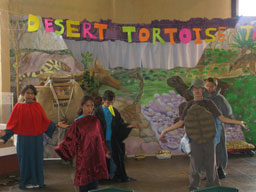Education Programs on offer to schools
The Desert Discovery Center (DDC) currently offers two environmental education programs that focus on fostering responsible stewardship in the youth of Barstow and surrounding communities. The first program is the Jr. Naturalist Program. This program, which is offered throughout the school year, is operated through field trips to the DDC. Elementary and intermediary schools in the area travel to the DDC for half-day or whole-day programs which teach students about subjects ranging from biology and botany to Leave No Trace ethics and the Closing the Loop curriculum. All programs are taught in correspondence to California State Educational Standards, but are intentionally more hands-on than a traditional classroom setting. We believe that if we can get students excited about what is happening in the desert—the unique ecosystem, and wildlife therein—then these people will grow up to become more responsible adults and more motivated to protect this fragile resource.
Currently, most of the classes coming to the DDC are from the High Desert Region, but our program is expanding. Discovery Trails, a DDC partner secured a grant to purchase a CNG (compressed natural gas) 72 passenger school bus. Within the next few months we will have the capability to pick students up from other school districts and transport them to the DDC as well as Rainbow Basin, Calico Early Man Site, and other areas of interest on our public lands. In addition to that, the DDC participates in a program through the Mojave Environmental Education Consortium (MEEC) which pays for the transportation of entire grade levels of students to the DDC from other school districts so that other communities can benefit from our programs.
During the summer the DDC offers the Jr. Naturalist Summer Day Camp. This program is similar to the scholastic program in that it offers some of the same curriculum. It differs, however, in that we have all day access to the same kids for a week at a time, and that we are able to supplement each class with a field trip to reinforce what they have learned in the classroom setting. In addition to the subjects offered during the school year, the Summer Day Camp offers a class in Community Leadership so as to further associate being environmentally conscious with being a good citizen.
  
Climate
Barstow is fortunate to have a very desirable climate. The high desert climate offers warm summers, with an average daily temperature of 102 degrees. Of special note is the rapid cool-down during the summer months in the evening, resulting in very pleasant nights. Summertime humidity levels average less than 40%, the comfort factor is only slightly affected.
The winter temperatures are moderate, comparable to Phoenix. Winter highs range between 50 and 70 degrees. Winter low temperatures average about 44.8 degrees, with extreme low temperatures of 25 degrees. Air quality is excellent, and smog is an unknown word here. Average annual rainfall is about 4 inches.
Ecosystems
The transition from the hot Sonoran Desert to the cooler and higher Great Basin is called the Mojave Desert. This arid region of southeastern California and portions of Nevada, Arizona and Utah, occupies more than 25,000 square miles.
Focal Plants
The Mojave Desert hosts about 200 endemic plant species found in neither of the adjacent deserts.Cactus are usually restricted to the coarse soils of bajadas. Mojave Yucca and, at higher elevations Desert Spanish Bayonet, a narrow-leafed yucca, are prominent. Creosote Bush, Shadscale, Big Sagebrush, Bladder-sage, bursages and Blackbush are common shrubs of the Mojave Desert.
The community of desert plants includes both “perennials,” i.e., the plants that, by definition, live for more than one growing season, and “annuals,” or, perhaps more accurately, “ephemerals,” i.e., plants that bloom (provided they receive well-timed rain) and die within a single warm or cold season. The perennials (not all authorities agree on the term) include plants such as the columnar cacti, the prickly pears, the chollas, the yuccas, the agaves, the sotols, the Ocotillo and the omnipresent Creosote Bush. The ephemerals include, for a few examples, various poppies, daisies, penstemons, lupines, milkweeds, mallows and the Sacred Datura.
The desert plant community, as marked by the diversity and distinguishing characteristics of the various species, has been shaped, of course, by our arid and erratic climate and nutrient-starved soils.
Euro-American History
More than 2,000 years ago, the Mojave Desert had been occupied by Indian tribes who lived beside the immense lakes that covered most of the Mojave. In the late 1800s, the Barstow area became a mining center. Daggett, 5 miles down river, was founded in the 1860s. It was originally called Calico Junction but was renamed after California Lieutenant Governor John Daggett when silver was discovered 6 miles north in the Calico Mountains in 1882.
The finding of silver in Calico and the building of the Southern Pacific Railroad from Mohave to Daggett in 1882 made the area a mining center. The famous 20-mule teams came into being when 10 teams were hitched together with two wagons and a water wagon to haul ore from Daggett to the town of Calico.
The Calico Railroad (later called the Daggett-Calico Railroad) started hauling ore from Calico to the Oro Grande Milling Company, across the river from Daggett in 1888. That same year, the Santa Fe Railroad arrived in town. The town was later named after the president of the Santa Fe, William Barstow Strong. The mine shut down in 1896 when all the silver had played out.
But in 1883, the borax rush hit Calico, and by 1902, three borax mines employing 200 men supported Daggett. It is estimated that borax taken from the Calico Hills amounted to more than $9 million, while more than $90 million in silver was removed. As the 20th century progressed, Calico and Daggett diminished while Barstow grew. It became a busy rail center and a jumping off place for immigrants entering the state on US Route 66, as made famous by John Steinbeck's novel "The Grapes of Wrath." Modern and historic facilities are still available along Barstow's Main Street, the original Route 66. Just off Main Street, at First Street, travelers can drive over an old iron bridge that leads to the railroad depot once the site of the historic Harvey House, originally opened in 1911.
With the construction of the modern Interstate Highway system Barstow's future of growth was assured, as I-40 and I-15 converged at the city limits with State Highway 58, making it the transportation hub of the western Mojave Desert.
|








